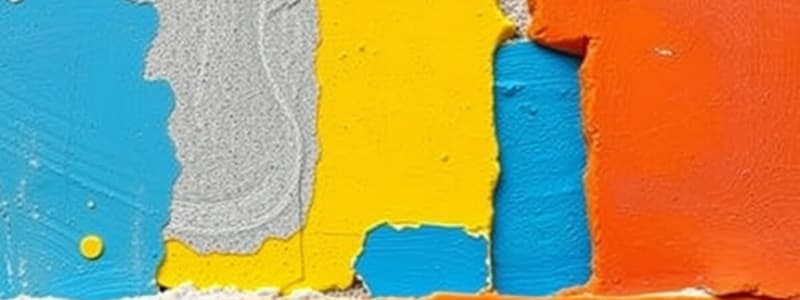Podcast
Questions and Answers
What is the maximum allowable lime content in Class I mortar when using common cements?
What is the maximum allowable lime content in Class I mortar when using common cements?
- Up to 25 kg
- None
- No limit specified
- Up to 10 kg (correct)
Under what condition can the types of sand and cement in a strength mortar be altered during construction?
Under what condition can the types of sand and cement in a strength mortar be altered during construction?
- Only when directed by the architect
- If the alteration is cost-effective
- If tests show required strength can be achieved (correct)
- If it is more readily available
What method should be used for measuring materials for mortar to ensure consistent proportions?
What method should be used for measuring materials for mortar to ensure consistent proportions?
- Weight batching of one material only
- Volume batching of all materials
- Weight batching of all constituent materials (correct)
- A combination of volume and weight batching
What is the correct amount of cement required for 2 standard wheelbarrows of Class I mortar using common cements?
What is the correct amount of cement required for 2 standard wheelbarrows of Class I mortar using common cements?
Which type of cement is not permitted to have lime added in Class II mortar?
Which type of cement is not permitted to have lime added in Class II mortar?
Flashcards are hidden until you start studying
Study Notes
Mortar Specifications
- No mortar plasticizers or set-retarding admixtures should be introduced unless specifically allowed.
- Changes to sand and cement types in strength mortar are permitted only if tests confirm the desired strength.
- Consistent control over material proportions for mortar mix is essential during measurement and construction.
Prescribed-Mix Mortar
- Mortar mix proportions are outlined in Table 7.
- Class I Mortar:
- Common cements: 50 kg cement, 0-10 kg lime, max. aggregate size of 130 mm, equivalent to 2 standard wheelbarrows.
- Masonry cements (MC 22.5 X, MC 12.5): 50 kg cement, no lime, max. aggregate size of 80 mm, equivalent to 1 standard wheelbarrow.
- Class II Mortar:
- Common cements: 50 kg cement, 0-25 kg lime, max. aggregate size of 200 mm, equivalent to 3 standard wheelbarrows.
- Masonry cements (MC 22.5 X, MC 12.5): 50 kg cement, no lime, max. aggregate size of 130 mm, equivalent to 2 standard wheelbarrows.
Cement Measurement Guidelines
- Cement should always be measured by weight, not volume.
- A factory-packed 50 kg bag of common cement occupies approximately 33 L but may increase by up to 20% in bulk when poured, affecting measurement accuracy.
- It is recommended to use whole bags for volume batching due to variances in bulk density.
Lime Usage
- The use of lime with common cements is permitted within the specified maximum limits but cannot substitute for cement in the mix.
Wheelbarrow Specifications
- A standard wheelbarrow, conforming to SANS 795 (type 2), has a capacity ranging from 60 L to 70 L.
Studying That Suits You
Use AI to generate personalized quizzes and flashcards to suit your learning preferences.



